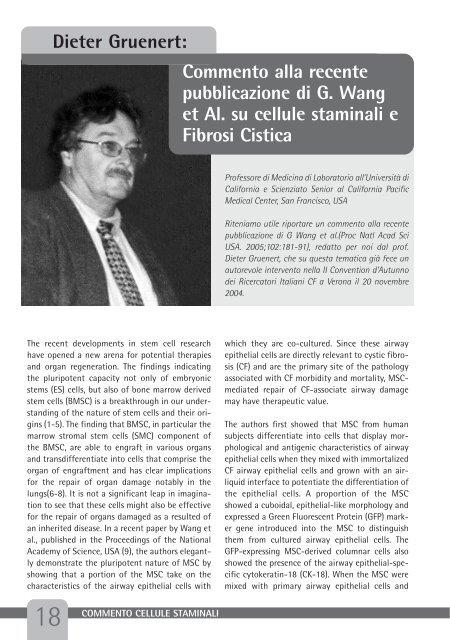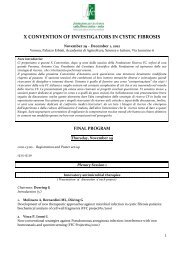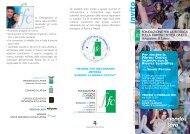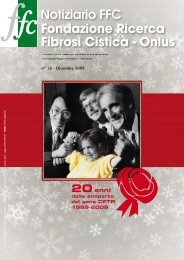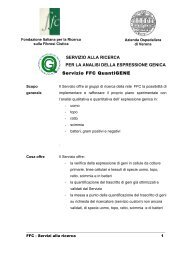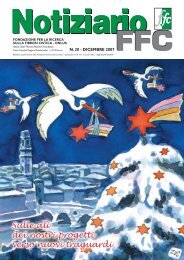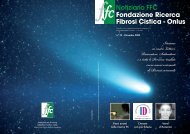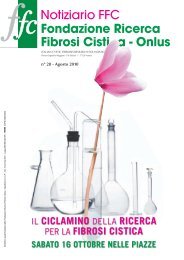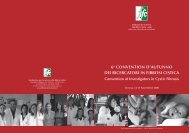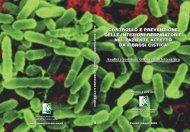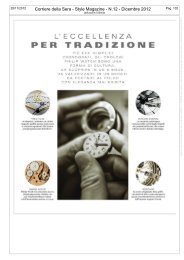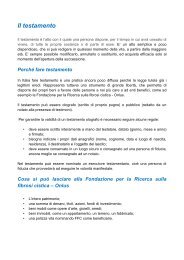Brochure Seminario di Primavera 2005 - Fondazione Ricerca ...
Brochure Seminario di Primavera 2005 - Fondazione Ricerca ...
Brochure Seminario di Primavera 2005 - Fondazione Ricerca ...
You also want an ePaper? Increase the reach of your titles
YUMPU automatically turns print PDFs into web optimized ePapers that Google loves.
The recent developments in stem cell research<br />
have opened a new arena for potential therapies<br />
and organ regeneration. The fin<strong>di</strong>ngs in<strong>di</strong>cating<br />
the pluripotent capacity not only of embryonic<br />
stems (ES) cells, but also of bone marrow derived<br />
stem cells (BMSC) is a breakthrough in our understan<strong>di</strong>ng<br />
of the nature of stem cells and their origins<br />
(1-5). The fin<strong>di</strong>ng that BMSC, in particular the<br />
marrow stromal stem cells (SMC) component of<br />
the BMSC, are able to engraft in various organs<br />
and trans<strong>di</strong>fferentiate into cells that comprise the<br />
organ of engraftment and has clear implications<br />
for the repair of organ damage notably in the<br />
lungs(6-8). It is not a significant leap in imagination<br />
to see that these cells might also be effective<br />
for the repair of organs damaged as a resulted of<br />
an inherited <strong>di</strong>sease. In a recent paper by Wang et<br />
al., published in the Procee<strong>di</strong>ngs of the National<br />
Academy of Science, USA (9), the authors elegantly<br />
demonstrate the pluripotent nature of MSC by<br />
showing that a portion of the MSC take on the<br />
characteristics of the airway epithelial cells with<br />
18<br />
Dieter Gruenert:<br />
COMMENTO CELLULE STAMINALI<br />
Commento alla recente<br />
pubblicazione <strong>di</strong> G. Wang<br />
et Al. su cellule staminali e<br />
Fibrosi Cistica<br />
Professore <strong>di</strong> Me<strong>di</strong>cina <strong>di</strong> Laboratorio all’Università <strong>di</strong><br />
California e Scienziato Senior al California Pacific<br />
Me<strong>di</strong>cal Center, San Francisco, USA<br />
Riteniamo utile riportare un commento alla recente<br />
pubblicazione <strong>di</strong> G Wang et al.(Proc Natl Acad Sci<br />
USA. <strong>2005</strong>;102:181-91), redatto per noi dal prof.<br />
Dieter Gruenert, che su questa tematica già fece un<br />
autorevole intervento nella II Convention d’Autunno<br />
dei <strong>Ricerca</strong>tori Italiani CF a Verona il 20 novembre<br />
2004.<br />
which they are co-cultured. Since these airway<br />
epithelial cells are <strong>di</strong>rectly relevant to cystic fibrosis<br />
(CF) and are the primary site of the pathology<br />
associated with CF morbi<strong>di</strong>ty and mortality, MSCme<strong>di</strong>ated<br />
repair of CF-associate airway damage<br />
may have therapeutic value.<br />
The authors first showed that MSC from human<br />
subjects <strong>di</strong>fferentiate into cells that <strong>di</strong>splay morphological<br />
and antigenic characteristics of airway<br />
epithelial cells when they mixed with immortalized<br />
CF airway epithelial cells and grown with an airliquid<br />
interface to potentiate the <strong>di</strong>fferentiation of<br />
the epithelial cells. A proportion of the MSC<br />
showed a cuboidal, epithelial-like morphology and<br />
expressed a Green Fluorescent Protein (GFP) marker<br />
gene introduced into the MSC to <strong>di</strong>stinguish<br />
them from cultured airway epithelial cells. The<br />
GFP-expressing MSC-derived columnar cells also<br />
showed the presence of the airway epithelial-specific<br />
cytokeratin-18 (CK-18). When the MSC were<br />
mixed with primary airway epithelial cells and


